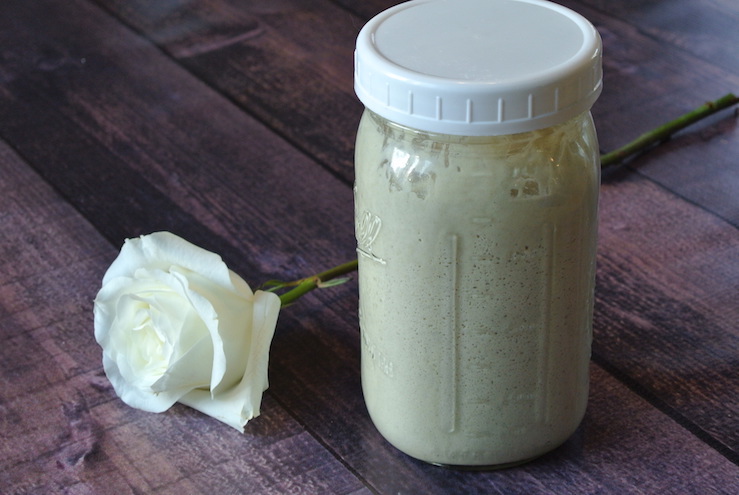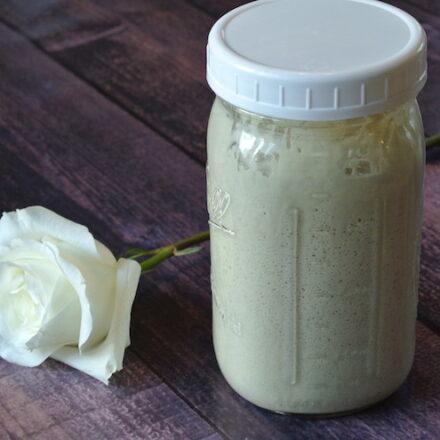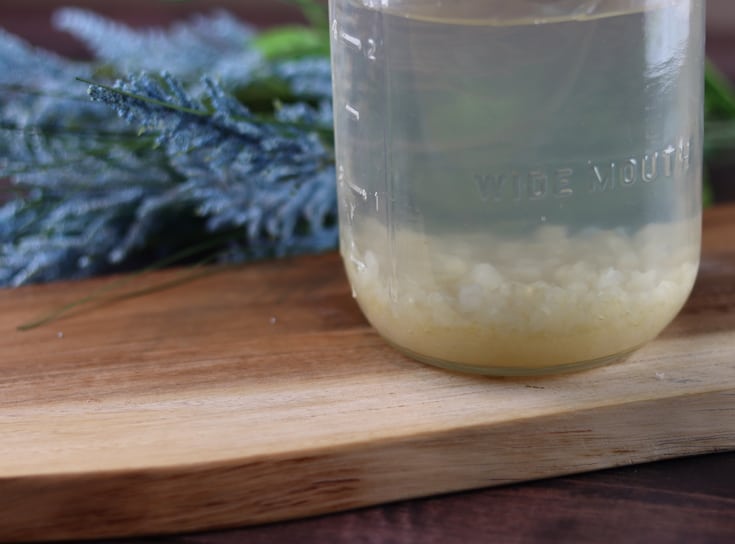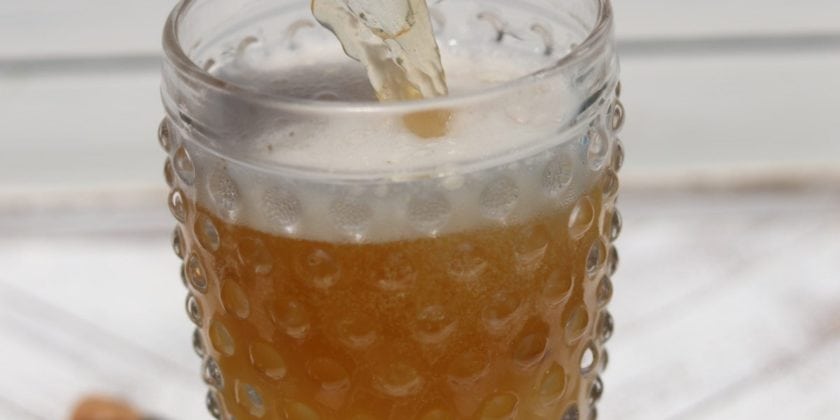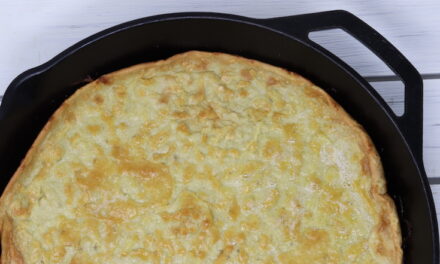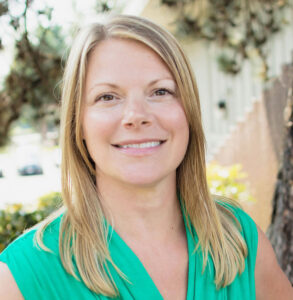This Buckwheat Sourdough starter is a gluten-free sourdough starter that tastes just as great as its wheat-containing brethren! Using a buckwheat sourdough starter gives you a nutritious as well as tasty way to make gluten-free breads, pancakes, crepes, cornbread, waffles, tortillas, and many other treats.
Once you have made your starter, try my recipe for Buckwheat Sourdough Waffles and pancakes. Or Buckwheat Sourdough Pumpkin Bread. Or Buckwheat Sourdough Sugar Cookies. Or Buckwheat Sourdough Ebelskivers. Or Buckwheat Sourdough Crepes. Yum!!
Why bake with Sourdough?
- Using a buckwheat sourdough starter allows you to bake without using commercial yeast. This is good because most commercial yeasts are genetically modified. If that isn’t enough to make you want to avoid them, many people unknowingly react to commercial yeasts.
- Using a buckwheat sourdough starter gives a closer texture to the wheat baked goods that you are used to without using additives.
- The process of fermenting the buckwheat (or any grain or seed) releases it’s phytates. This makes the vitamins and minerals in the fermented grain much more bio-available (ready for your body to use).
Starting with an established gluten free starter
I have baked with a wheat starter for years using an established wheat starter that I bought from Cultures for Health. I still use it as well as a whole wheat version that is also from them. An established starter gives you the most success and predictability with your baked goods, right out of the gate. It will also save you time!! It takes at least a week of feeding every 4-6 hours to start your own starter and it will most likely be years before it is baking as reliably as an established starter.
When I decided I wanted a buckwheat sourdough starter, I looked all over for an established one, but I could not find one. I ended up deciding to buy an established gluten-free sourdough starter that had been made with brown rice and training it to “eat” buckwheat instead. It was so easy, and I am so happy with the results!
Why I use A Buckwheat Sourdough Starter:
We needed a gluten-free sourdough starter because we are now a gluten-free household. M buckwheat sourdough starter allows me to make many of our old favorites gluten-free. Plus, buckwheat is a superfood! See below for a list of its nutritional highlights.
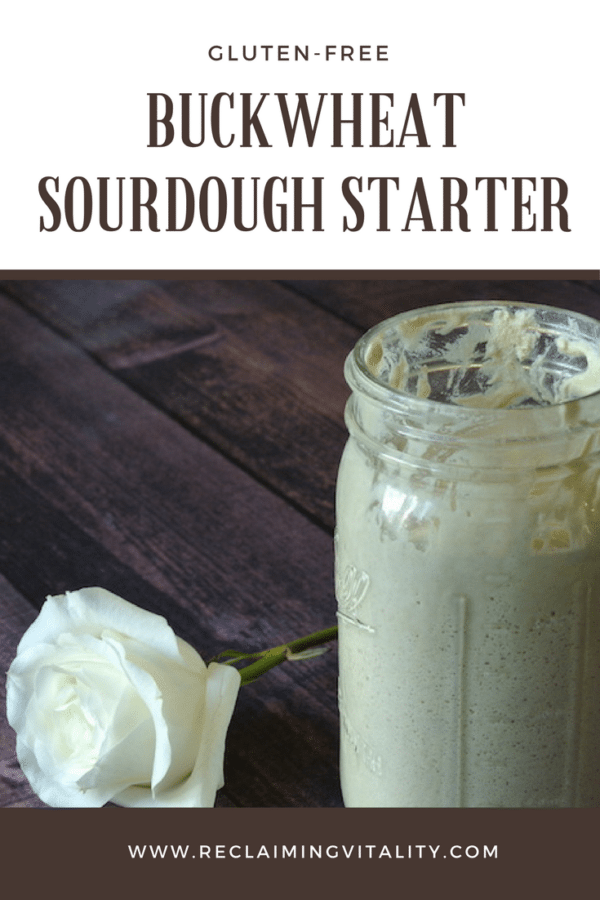
Why Buckwheat?
Buckwheat is not related to wheat at all. It is actually a seed related to rhubarb that:
- is loaded with magnesium (which most of us are deficient in).
- is a good source of potassium, iron, and B vitamins
- has more protein than any of the grains traditionally consumed in the SAD (Standard American Diet), such as wheat, rice, or corn.
- contains the essential amino acids lysine and arginine.
- contains a fair amount of resistant starch.
- is gluten-free and grain-free
- is much more nutritious that other flours that generally make up gluten-free flour blends such as corn, rice, millet, sorghum and tapioca.
My favorite Buckwheat flour is Acadian Buckwheat from Bouchard Family Farms. It has a much lighter texture than other Buckwheat flours. It has a much lighter texture and color than other Buckwheat flours. I first read about it in an excellent gluten-free baking book called Against the Grain. This is an awesome book if you are Celiac, gluten-intolerant, or would just like to start eating seasonally and need some wheat-free recipes. I almost always use Acadian buckwheat. Every now and then I grind my own flour fresh from buckwheat groats in the grain-grinding container of my high-powered blender. If you grind your own, your baked goods (and starter) will have brown specs and be a bit grainier to taste, but still very enjoyable. It will also have a higher nutrient content because it is freshly ground.
How to make a Buckwheat Sourdough Starter:
You will need to either purchase an established gluten-free starter or get one from a friend. It is not recommended to train a gluten-containing starter to eat a non-gluten containing grain or seed, as there will always be traces of gluten in it.
First: Rehydrate your Established starter

If you are using a purchased gluten-free starter (brown rice), follow the directions on the box until it is bubbling reliably within a few hours of feeding. (See the bottom of the post for the directions that came with my Cultures for Health Brown Rice Starter if you are interested.) If you are using a gluten-free starter from a friend, also make sure that it bubbles reliably within several hours of being fed. Once this happens, you can start training it to use buckwheat flour instead of brown rice four. In order to be on the safe side, always save some of your starter discard in case your starter doesn’t take to the new flour or there is some other unforeseen disaster. (Something like accidentally dumping it into some milk you are using to make cottage cheese thinking that it is milk kefir. On that note, I can’t underestimate the importance of labeling. You think that you will remember what that jar contains, and maybe you will…or maybe you won’t. 😉
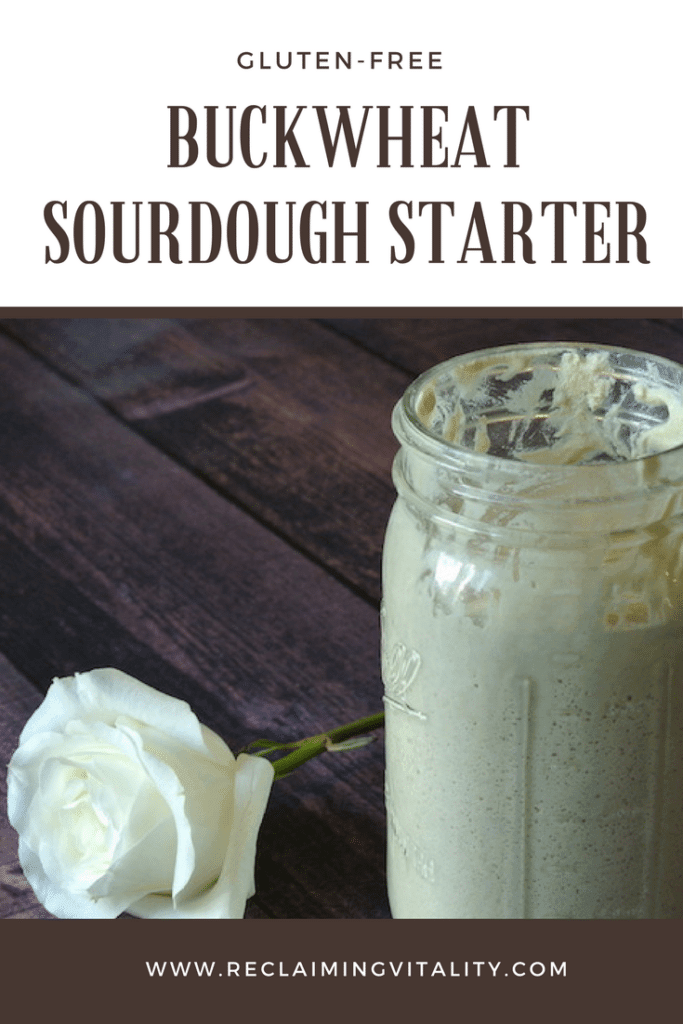
Second: Train your gluten-free starter to “eat” buckwheat:
- To start training your rehydrated established gluten-free starter, feed with a 1/2 and 1/2 mixture of the two flours. For example, take 1 tablespoon of your bubbling brown rice starter at the top of its rise and mix it with 1 tablespoon1 of brown rice flour and 1 tablespoon of buckwheat flour plus 1/4 cup of water. Mix well to aerate (get oxygen into the starter). Once the mixture is bubbling and happy, feed it again in exactly the same way. Do two or three feedings just like this. Be sure that it is bubbling within 6-8 hours of being fed. You now have a half brown rice, half buckwheat sourdough starter and you can maintain it like this if you like. I prefer my starter this way because brown rice and buckwheat complement each other well. If you are grain-free or just want only buckwheat in your starter, then you need to keep training.
- To continue training, remove 1 tablespoon of your new 1/2 and 1/2 starter and mix it with 1.5 tablespoons of buckwheat flour plus 1/2 tablespoon of rice flour and 1/4 cup of water for a few feedings.
- Once it is bubbling on schedule (after 6-8 hours of being fed), you can now feed with just buckwheat.
- If your starter doesn’t rise as well with just buckwheat, go back to step 2 for one or two feedings. Or, you can always add a bit of brown rice flour to your buckwheat starter if you don’t have to be completely grain-free. You could also add some water kefir in place of some of the water to get a boost in your starter.
- To get your starter ready to bake with, you will want to increase the amount that you are feeding it. (Assuming that most recipes call for a cup or more of bubbling starter. In order to do this, you just keep the same ratios, but increase the amounts. For example, take 1/2 cup of starter and feed with 1 cup of buckwheat flour (or one cup of any combination of buckwheat and brown rice flour) and 3/4 cup of water. It shouldn’t take any longer to rise (6-8 hours).
Maintaining Your Gluten-free, Buckwheat Sourdough Starter:
- To maintain your starter, keep it in the fridge when you are not using it. Feed it at least once a week in for the first few months.
- Once it is a nice healthy starter, you can feed it once a month if you are not using it (such as during a certain season).
- Feed your starter right before you put it in the fridge and use minimal water so that the bacteria “eat the flour” slowly. You may get a line of grayish liquid on the top of the starter after a bit of time in the fridge. This is called the “hooch” and is nothing to be concerned about. You can either pour it off before feeding or mix it in and then remove your discard starter.
- Feed your starter at least once and preferably twice before baking with it. If it does not bubble within 6-8 hours, feed it again until it does before using it. A bubbly starter is needed for successful baked goods!
- Boost your starter is to replace 1 tablespoon of the water with water kefir.
- Be sure to spread the love and share your buckwheat sourdough starter with friends and family!
Notes on working with your buckwheat sourdough starter:
- When feeding your starters, keep them at room temperature (70-90 F or 2-3 C). If you want to store your starter, feed it and then put it in the fridge. My rule is if I am not baking with it that day or the next, to put it in the fridge.
- You can use more or less water than advised here depending on your needs. If you add more water, the starter usually rises faster. If you cut the water, the starter will rise more slowly. This can be advantageous if you have to leave for work for 8 hours and won’t be able to feed your starter.
- I use Bormolio Rocco glass jars now instead of Mason jars. They have the lids with seals attached and there is less risk of lead contaminating your ferments.
- The remaining starter that you did not use when doing feedings is called “discard” starter. You can discard it, but there are many recipes that make use of discard starter, so I always keep a jar of it in the fridge. In fact, sometimes I feed my starter more often to get more of it! Sourdough buckwheat pancake/waffles use discard starter but can be used with active starter as well.
- To get your gluten-free sourdough starter ready to bake with, you will want to increase the amount that you are feeding it. (Assuming that most recipes call for a cup or more of bubbling starter. In order to do this, you just keep the same ratios, but increase the amounts. For example, take 1/2 cup of starter and feed with 3/4 cup water, 1 cup of buckwheat flour (or a combo of buckwheat and brown rice flour.)
Buckwheat Sourdough Starter
Ingredients
- Brown Rice Four
- Buckwheat flour I use Acadian Buckwheat
- Gluten-free sourdough starter culture brown rice
- Filtered water
Instructions
- If you are using a purchased starter, follow the directions on the box until it is bubbling reliably within a few hours of feeding. If you are using a gluten-free starter from a friend, also make sure that it bubbles reliably within a few hours of being fed. Once this happens, you can start training it to use buckwheat flour instead of brown rice four. In order to be on the safe side, always save some of your starter discard in case your starter doesn't take to the new flour or there is some other unforeseen disaster.
To start training your starter
- Feed with a 1/2 and 1/2 mixture of the two flours. For example, take 1 tablespoon of your bubbling brown rice starter at the top of its rise and mix it with 2 tablespoons of brown rice flour and 2 tablespoons of buckwheat flour plus 1/4 cup of water. Mix well to aerate (get oxygen into the starter). Once the mixture is bubbling and happy, feed it again in exactly the same way. Do two or three feedings just like this. Be sure that it is bubbling within 6-8 hours of being fed. You now have a half buckwheat, half brown rice starter and you can maintain it like this if you like. I prefer my starter to be half buckwheat, half brown rice because they complement each other well. If you want are grain-free or just want only buckwheat in your starter, then you need to keep training.
- To continue training, remove 1 tablespoon of your new 1/2 and 1/2 starter and mix it with 3 tablespoons of buckwheat flour plus one tablespoon of rice flour and 1/4 cup of water for a few feedings.
- Once it is bubbling on schedule (after 6-8 hours of being fed), you can now feed with just buckwheat.
- If your starter doesn't rise as well with just buckwheat, go back to step 2 for one or two feedings. Or, you can always add a bit of brown rice flour to your buckwheat starter if you don't have to be completely grain-free.
- To get your starter ready to bake with, you will want to increase the amount that you are feeding it. (Assuming that most recipes call for a cup or more of bubbling starter. In order to do this, you just keep the same ratios, but increase the amounts. For example, take 1/2 cup of starter and feed with 3/4 cup water, 1 cup of buckwheat flour (or one cup of any combination of buckwheat and brown rice flour. It shouldn't take any longer to rise (6-8 hours).
Do you bake with buckwheat? Have you tried making a buckwheat sourdough starter? Have you baked with another gluten-free sourdough starter?
Keep in touch!
We love pinning on Pinterest!
However, our favorite way to keep in touch is through email! Subscribe and never miss a post. Plus, get access to the Holistic Health Resource Library. There you can download ebooks, PDFs, and Homeopathic Remedy Cards by condition for FREE!
You will also get emails with information on how to incorporate true holistic healing into your life. Absolutely no spam!
Evidenced-based Nutrition:
If you would like to figure out what the perfect diet is for YOUR body, functional nutritional therapy is for you!

